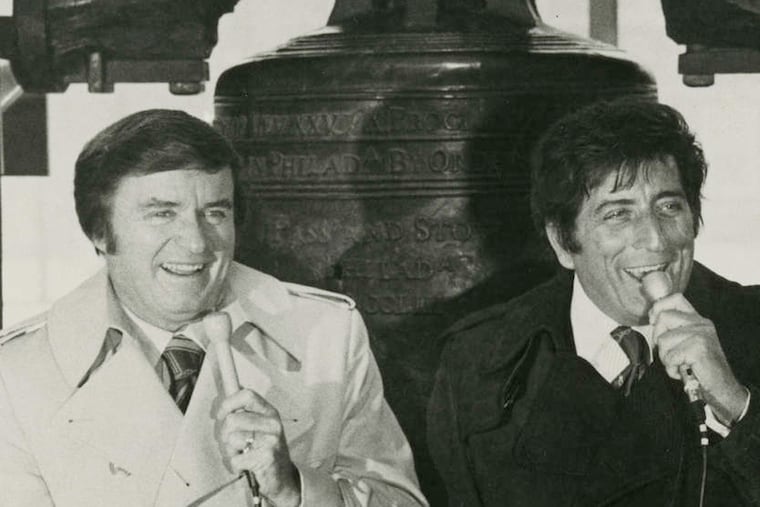Mike Douglas ruled Phila. TV
When it comes to Philadelphia's connection to the history of television, many believe it to stretch only as far as the hemlines and pegged pants of modish teens on American Bandstand. However, the city's pixilated past deserves a high-definition look.

When it comes to Philadelphia's connection to the history of television, many believe it to stretch only as far as the hemlines and pegged pants of modish teens on American Bandstand. However, the city's pixilated past deserves a high-definition look.
It was at the Franklin Institute that inventor Philo Farnsworth demonstrated the first electronic television set to the public. TV Guide launched its channel safaris from a small office in Center City, while the inventor of instant replay, Tony Verna, also called the city home.
The Mike Douglas Show, which moved to Philadelphia 50 years ago, deserves a special tuning-in.
The program ran for more than two decades. At its zenith, more than seven million people watched the daily broadcast, one of the most popular shows on television.
Douglas, born Michael Delaney Dowd Jr., first strove to be a professional singer. A natural tenor, he began as a choirboy in Chicago before picking up crooning chops during a gig aboard a Great Lakes cruise ship.
A notable career in the big band scene awaited Douglas' return to the States following a stint in the Navy during the Second World War. Catching the ear of the bandleader Kay Kyser, Douglas quickly joined his Kollege of Musical Knowledge as a vocalist.
As big band music waned in popularity, usurped by the insurgent sounds of early rock-and-roll, Douglas struggled to support himself and his wife. Despite being cast by Walt Disney himself as the singing voice of Prince Charming in the 1950 film Cinderella, Douglas considered giving up his show business dreams to become a real estate agent.
His "big break" happened not in Los Angeles, but in that other cauldron of celebrity: Cleveland. A former friend from Douglas' Chicago days asked if he would host a local talk show filmed in what is now the Rock and Roll City.
Styled The Mike Douglas Show, the daytime variety program debuted in 1961 and quickly garnered a loyal following.
Hoping to attract more famous guests - including those unwilling to travel to Ohio - the production relocated to KYW's former studio at 1619 Walnut St. in 1965. Six years later, Douglas and crew moved into a purpose-built studio at Fifth and Market Streets.
The show's dynamic was simple, its reception great. Unlike contemporaries such as Johnny Carson, Douglas began each show with a musical number in place of the traditional monologue. Guests would often cohost for an entire week, participating in the show's sketches and other performances alongside the perennially affable Douglas.
"Dishes go unwashed and shirts remained un-ironed when Mike Douglas comes on," TV Guide proclaimed.
With such a broad viewing audience, many aspiring artists, musicians, and actors appeared on the show. Barbra Streisand, Jay Leno, and other performers made a name for themselves by appearing with Douglas.
The host's everyman demeanor drew a cornucopia of celebrities. From Truman Capote to Malcolm X, from Sen. Barry Goldwater playing trombone to Ray Charles riding a motorcycle, the guest list is a who's who of American culture and politics in the '60s and '70s.
Asked about the secret to his success, Douglas replied: "I'm a square."
Even Tiger Woods made his first television appearance on the program, stopping in to show off his preternatural putting skills - at 2 years old.
"I don't know what kind of drugs they've got this kid on," opined Bob Hope, that week's cohost, "but I want some."
One week in 1972 stands out, when Douglas was joined by cohosts John Lennon and Yoko Ono.
"I asked him today, you know, when are you going to run for president?" joshed Lennon, referring to Ralph Nader, who made one of his first television appearances on the show.
The former Beatle offered suggestions about Nader cabinet appointments, saying Ono "can be minister of peace and I'll be minister of music." One part of that prospect sounds pleasant.
Things took a turn for the tense after Lennon invited on stage the antiwar activist Jerry Rubin and Black Panthers leader Bobby Seale. "Square" Douglas hadn't looked so squeamish since Zsa Zsa Gabor called Morey Amsterdam a "son of a bitch" for interrupting her in 1965. After that episode, the show ceased to be broadcast live, in favor of a seven-second delay.
After an estimated 6,000 broadcasts at 90 minutes apiece, Douglas left the show, uttering his catchphrase, "I'll be right back," for the last time in 1980. His efforts had netted five Emmy awards, including the first honoring daytime programming.
Philadelphians were proud of Douglas. The 1971 Phillies took to the field for the first time in the new Veterans Stadium following Douglas' rendition of "The Star-Spangled Banner."
Shortly after his death on his 86th birthday in 2006, the Broadcast Pioneers of Philadelphia posthumously inducted Douglas into its Hall of Fame. The KYW news studio at Fifth and Market was known as "the house that Douglas built."
As current KYW anchor Ukee Washington remembered at the time of Douglas' death, "I was in awe. I grew up watching his show. I couldn't wait to get home from school. In Philly, everybody watched Mike Douglas."